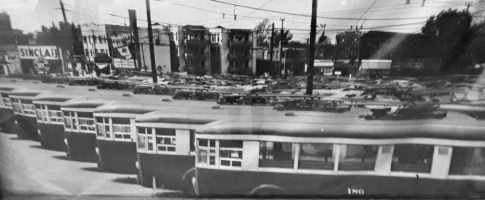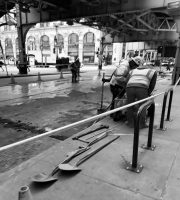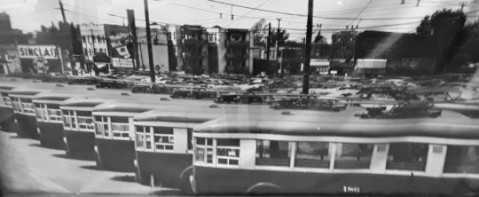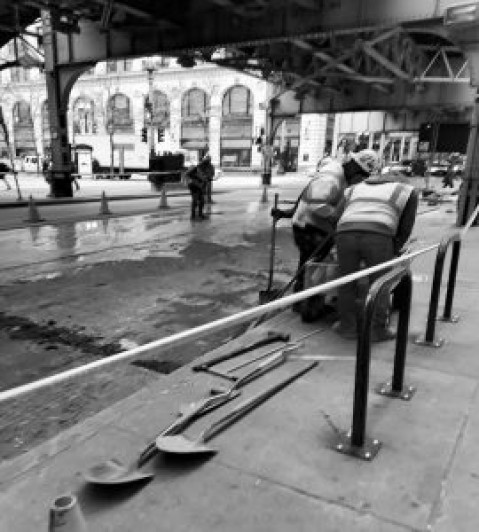Widgetized Section
Go to Admin » Appearance » Widgets » and move Gabfire Widget: Social into that MastheadOverlay zone
Navigating the Ruins of Political Discourse: Public Service as Crisis Management
The views expressed are those of the author and do not necessarily reflect the views of ASPA as an organization.
By Lisa Saye
November 12, 2018

Photo of old Chicago Buses. Chicago, Illinois, Photo by Lisa Saye
Old Photos, New Memories and How Ruins Help Us to See Straight
When I think of ruins, the picture that comes to mind is of a dismantled and mangled structure leaning and crumbled against itself. I see burned out beams and scorched concrete amidst a backdrop of dust and wires. I also see neglect. When we allow our creations to waste away, to become and to remain ruins, we neglect our own dreams and the very reasons why our creations were made and designed in the first place.
In the U.S., the notions of equality that are embedded in our government are in danger of neglect toward ruin. Just when one thinks that they have heard it all and that no comment or tweet or television ad or robocall can shock them—they become shocked anew. Our present environment inspires all sorts of new notions loosely defined as government, but when looked at critically, these notions are simply acts and statements of incivility and hatred. And if government and the governed continue to allow these things to occur, we will no longer deserve the awe and admiration of the world as the democracy that lives to correct itself.
Memories are interesting things. Memories give life its flavor, its heartbeat and its never-ending graphic. We bring memory into everything we encounter. Photos present a moment in highlight—in color or in black and white. Photos allow us to remember again what we packed away as part of our journey. I wonder which photos we will use from today’s highlights when we elicit future memories about the way we treated each other. What will those memories tell us about ourselves, our government, our service and our indifference?
While on the subway in Chicago, I overheard a rider tell another rider that the monument that the citizens erected and dedicated to President James Garfield in his hometown was unnecessary because he was a ‘useless president who only managed to get himself shot.’ I sighed with irony with the knowledge that part of the very bureaucracy carrying the rider, myself and others under and over Chicago’s streets was started during the Garfield administration—most notably when Garfield sent Dorman B. Eaton to England to study its civil service reform process. And of course, Garfield’s assassination in 1881 led the way for the Pendleton Act of 1883 which established the merit system in the federal government. That rider remembered President Garfield as useless, but my memories of his efforts and contributions are very different.
Indifference is very similar to this subway example. A story may sound great and the way that one tells it may sound exciting, but that in itself does not make the story true. The truth is often flavorless, but lasting. The truth stands alone, but it stands. The one place citizens look to for some semblance of truth has always been in government. They look for fairness in their governments and in their government officials. Government is the place where truth must always reside.

Chicago workers repairing the street. Chicago, Illinois, Photo by Lisa Saye
No Ruins On My Watch
We now live in a time when governments around the world have opted to spend precious time testing the bounds of civility by moving the line closer and closer to who knows what. For evidence, one can recall the rise in the numbers of restrictive travel and immigration policies, the emergence of new voter suppression laws, the rise in hate crimes, the rise of hate speech, the innumerable clothing bans or the denial of benefits to the neediest among us. While this has been the environment that public servants have had to navigate within, it cannot become the norm. Public servants have to continue to place decency over meanness. Our work should not become society’s next ruin on the tour of what used to be. We must work to uphold our vocation, no matter how the trends attempt to bend us.
I want to return to the notion of ruins for a moment. While ruins tell us who and what we used to be, they do not always define who we are now or what we can still become. It will take some courage and more than a pinch of salt, but public servants must gather up the charred remains of our dignity, our integrity and our civility. We can do this because we understand the normality inherent in helping all people. We know what it means to really change lives and we know how to do it.
Today, I noticed a homeless man ripping apart a box. He sat on a bench at a bus stop and penned various Help signs on the front and back of each piece. He sat there, writing out the narrative of his situation in short, drastic phrases. It was one of the saddest events I have ever witnessed and I have never felt more helpless. But, instead of not engaging or looking away, I did what public servants do and have always done at times like these. I helped.
Images: All images were taken by Lisa Saye in Chicago, Illinois.
Author: Lisa Saye teaches Applied Statistics and Research Methods at The School of Public Service at DePaul University. She served as Fulbright Specialist in Phnom Penh, Cambodia and as International Consultant for the United Nations Development Program in The Maldives. In April, she attended the United Nations High-Level Meeting on Peace-Building and Sustaining Peace as an Observer. Saye earned her Master’s in Human Resource Management from Troy University and her Doctorate in Public Administration from The University of Alabama. She can be reached at [email protected].






 (9 votes, average: 4.89 out of 5)
(9 votes, average: 4.89 out of 5)
Dr. Lisa Saye
November 19, 2018 at 9:09 pm
Many thanks for your warm comments, Mike.
Dr. Lisa Saye
November 19, 2018 at 9:08 pm
Thanks, Rukaya.
Rukaya Mohammed
November 14, 2018 at 10:25 pm
Another interesting story with nice photo. Keep it up.
Mike Nwosu
November 13, 2018 at 11:50 pm
As always, Prof. Saye has done justice to how to navigate the ruins of political discourse. A five-star article.
Marquice Robinson
November 13, 2018 at 7:24 pm
Hello Dr. Saye,
Great job with the article. I guess the saying is true, “a picture can speak a thousand words”. Another great job!